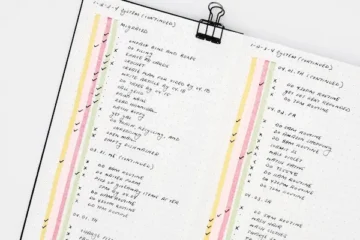Split Big Tasks Into Easy, Doable Steps
Discover how to split big tasks into smaller, doable steps that make your routine lighter, reduce stress, and boost productivity.
Who hasn’t looked at a huge task and thought, “Where do I even start?”
It happens at work, at school, and even in personal life.
Big projects often feel like mountains that can’t be climbed.
And this feeling of weight often leads to procrastination, stress, and sometimes giving up.
But there’s a simple secret to handle this: learning how to split big tasks into smaller, practical, and doable steps.
When you turn something huge into small pieces, what once felt impossible becomes easier to organize, track, and complete.
In this article, you’ll learn everything about breaking down big tasks, why it works, what mistakes to avoid, and which techniques really help in practice.

Understanding how to split big tasks
Before anything else, it’s essential to understand the deeper meaning of splitting big tasks.
It’s not just about “writing things on a list” and hoping for the best.
It’s about strategically breaking down a large, sometimes overwhelming goal into smaller, manageable steps that can be accomplished one at a time.
When you truly learn how to split big tasks, you create a roadmap that makes the journey clearer, less intimidating, and much more achievable.
This method not only improves productivity but also helps your mind stay calmer and more focused.
Big projects can easily create mental blocks because they feel too heavy to handle.
By slicing them into smaller parts, you transform that weight into clear, actionable steps.
Here’s why this approach is so powerful:
- Big tasks look overwhelming – the sheer size often paralyzes you before you even begin.
- Breaking them down creates progress – every small step completed adds to the bigger picture.
- Each finished step builds momentum – progress energizes you to keep moving forward.
- The whole process feels more organized – instead of chaos, you gain structure and direction.
- Smaller steps fit into your schedule more easily – making it practical to move forward even with limited time.
- Confidence grows naturally – because with every small win, you realize the big goal is actually within your reach.
By adopting this mindset, you turn intimidating goals into a series of manageable actions — and that’s what keeps motivation alive until the task is fully completed.
Benefits of how to split big tasks
Making a habit of breaking down large tasks into smaller pieces brings benefits you’ll notice right away.
This approach not only lightens your mental load but also transforms the way you work, creating a sense of progress and accomplishment that fuels motivation.
When you understand the real advantages of how to split big tasks, you realize that small steps are the foundation of big achievements.
Here are some of the key benefits explained in detail:
- More focus – By dividing a project into smaller steps, you know exactly where to start and avoid the paralysis of not knowing what to do first.
- Less procrastination – Smaller steps feel less intimidating, making it easier to take action and build momentum.
- Better discipline – Advancing in stages encourages consistency, helping you maintain steady progress over time.
- Continuous motivation – Each completed step feels like a win, giving you energy and confidence to tackle the next one.
- Improved time management – Smaller steps fit more easily into your schedule, making it possible to move forward even when you only have short periods of time.
- Reduced stress and anxiety – Instead of being overwhelmed by the size of the task, you focus on manageable actions, which brings peace of mind.
- Higher quality results – Because you’re tackling the task in smaller parts, you have more time to review details and refine your work.
- Clearer progress tracking – It’s easier to measure how far you’ve come when you can see each small step checked off a list.
In short, splitting big tasks into smaller, doable steps turns intimidating projects into achievable goals.
It helps you stay consistent, motivated, and in control — making both your personal and professional life lighter and more productive.
Common mistakes in how to split big tasks
Even though the concept of breaking down big tasks is simple, many people still struggle when applying it in real life.
These mistakes can make the process confusing instead of helpful, turning what should be a productivity booster into an added source of frustration.
Understanding these pitfalls is the first step to avoiding them and making sure your plan works smoothly.
Here are the most frequent mistakes explained in more detail:
- Vague splitting – Writing steps like “work on project” or “prepare documents” doesn’t help. Without clarity, each step creates new confusion instead of offering guidance. A good step should be actionable, such as “write the introduction section” or “create a budget spreadsheet.”
- Creating steps that are still too big – If you break down a task but the result still feels overwhelming, you need to split it further. For example, instead of “organize the house,” break it down into “sort kitchen cabinets,” “pack clothes,” and “clean living room.”
- Skipping deadlines – Steps without time limits are often forgotten or pushed indefinitely. Assigning a realistic timeframe to each small task helps create urgency and accountability.
- Ignoring priorities – Not all parts of a project carry the same weight. Some actions move the project forward faster, while others can wait. Without prioritization, you may spend time on less important steps and miss key goals.
- Leaving steps disconnected – A set of random tasks without a logical sequence makes progress harder to track. Each step should connect to the next like building blocks, forming a clear path toward the final goal.
- Overplanning without action – Some people spend too much time dividing tasks without actually starting them. Planning should make execution easier, not delay it.
- Not reviewing and adjusting – Life changes, and so do priorities. If you never revisit your task breakdown, you risk working on an outdated plan. Regularly reviewing and adapting your steps keeps your progress on track.
By being aware of these mistakes and learning how to avoid them, you turn the simple act of breaking down tasks into a powerful strategy.
It’s not just about writing smaller steps — it’s about making each one clear, realistic, and connected, so your big goal becomes achievable step by step.
How to split big tasks step by step
Now that you understand the mistakes, let’s look at the practical steps to do it effectively.
Define the main objective
Start by identifying the bigger goal or task.
Write it clearly, like “Submit final college paper” or “Organize a house move.”
Break into broad blocks
Divide it into wide categories, such as “research,” “writing,” and “reviewing” for a paper.
Turn blocks into smaller steps
Each block should be turned into actionable tasks, such as “research three articles,” “write introduction,” or “pack clothes.”
Set a logical order
Arrange the steps in a sequence that makes sense, so you don’t get lost along the way.
Assign realistic deadlines
Give each step a time frame, avoiding leaving everything until the last minute.
Track and adjust
Review regularly, and if needed, break a step down even further until it’s completely doable.
Tools that help with how to split big tasks
You don’t need to do everything alone.
There are tools that make breaking down tasks much easier.
| Tool | Main functionality | Best for |
|---|---|---|
| Trello | Visual boards with cards and lists | Teams and personal projects |
| Notion | Flexible blocks for organization | People who like customization |
| Todoist | Task lists with priorities | Users looking for simplicity |
| Google Keep | Quick notes and checklists | Fast reminders on mobile |
| Paper planner | Manual view with checkboxes | People who prefer pen and paper |
How to split big tasks at work
At work, splitting big tasks is crucial to stay on top of demands.
Projects become clearer, deadlines are respected, and teams work more smoothly.
- Break projects into weekly deliverables.
- Assign responsibility for each step.
- Use quick check-ins to review progress.
- Prioritize the steps that impact results the most.
How to split big tasks in personal life
It’s not just at work that this technique works.
In personal life, breaking down big tasks also brings order and lightness.
- Organizing a party → divide into invitations, food, decoration, and music.
- Planning a trip → split into tickets, accommodation, itinerary, and packing.
- Moving house → break into cleaning, packing, transport, and final organizing.
How to split big tasks with time blocks
A powerful technique is combining task breakdown with time blocking.
This ensures each step has its own space in your agenda.
- Morning block: for tasks that need high focus.
- Afternoon block: for meetings or collaborative tasks.
- Evening block: for reviews or lighter activities.
How to split big tasks and stay motivated
Breaking tasks down helps, but motivation is what guarantees you’ll finish.
That’s why you should celebrate every small achievement and acknowledge your progress.
- Use checklists to mark completed steps.
- Give yourself small rewards after finishing milestones.
- Remember: consistency matters more than perfection.
Best practices for how to split big tasks
For this habit to truly work, follow a few best practices:
- Be specific when writing each step.
- Don’t hesitate to split again if a step feels too big.
- Use tools that make visualization clearer.
- Review your list weekly.
- Adjust deadlines when needed, but never abandon the process.
Compliance and transparency
This article is for educational purposes and aims to share best practices on how to split big tasks in a practical and accessible way.
We have no affiliation, endorsement, or control over the tools, brands, or platforms mentioned.
The information here is general and should be adapted to your reality.
Our goal is to provide reliable, safe content aligned with Google’s compliance and best practice guidelines.




